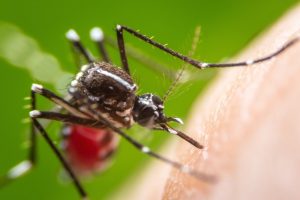The Science Behind Why Mosquitoes Prefer to Bite Certain People

The mosquito's sense of smell
Genetic factors
Environmental factors
Mosquito-borne diseases
Conclusion
References
Further reading
Mosquito bites are annoying, unpleasant, sometimes painful, often the cause of allergic reactions – but also potentially deadly. These insects kill more people than any other animal on Earth.

Image Credit: khlungcenter/Shutterstock.com
Mosquitoes transmit pathogens that cause serious tropical diseases such as malaria, dengue, Zika, West Nile virus, and Japanese encephalitis. Global warming is causing mosquito habitats to expand northward, threatening an increased mosquito-borne disease (MBD) burden in the future.
People who strongly attract mosquitoes are obviously at higher risk for MBD. What is the science behind the differences in mosquito-human attractiveness?
The mosquito's sense of smell
Mosquitoes track down potential hosts with visual cues as well as with combinations of odorants called "kairomones". The final short-range phase of the mosquito's human-sensing flight is directed by the host's body heat. Heat and odor suffice for the versatile mosquito if CO2 sensing is impaired.
Mosquitoes have multiple 'noses' or olfactory organs – the antennae, the proboscis, and the maxillary palps. These are rich in olfactory receptors. The signals are carried back to olfactory sensory neurons (OSNs). Mosquitoes have up to 80 types of OSNs, depending on the species.
OSN axons that carry the same signals, irrespective of location, end in the same glomerulus, an organ in the brain mapping the odor source. These signals are processed to tell the mosquito where the host is.
Kairomones are chemical signals that attract one species to another for the benefit of the former. They play a crucial role in long-range mosquito-human attraction. Kairomones are detected by three types of olfactory or smell receptors: the odorant, gustatory, and ionotropic receptors (OR, GR, and IR, respectively).
The human scent is made up of hundreds of volatile substances forming individual signatures. These include carbon dioxide (CO2), lactic acid, ammonia, organic fatty acids, ketones, aldehydes, alcohols, and esters. Combinations of human kairomones are stronger than single attractants.
In many animal species, each OSN detects only one type of odor molecule, but a recent study in the mosquito species Aedes aegypti revealed that a single OSN tracks multiple olfactory receptors. This may explain how they sense the right blend of odorants that signals 'humanness.'
Mosquitoes sense CO2 in exhaled air from about 30 feet, using GRs on cpA neurons, making it the main long-range attractant. Body odors and CO2 are sensed by ORs on cpB and cpC neurons via the olfactory receptor co-receptor (Orco).
The antennal Ir8a receptors selectively recognize human odors in the presence of CO2. Deficiencies in the IR coreceptor genes Ir8a, Ir25a, or Ir76b weaken the response to human odors while preserving the preference for the strong attractors.
Individual kairomones like carboxylic acids produce minimal OR activation without CO2. Conversely, body odors enhance CO2 sensitivity. CO2 restores odor attractiveness in Orco-deficient mutants. Without ORs, selectivity for humans is lost.
Carboxylic acids include lactic acid, which is concentrated in the sweat of humans relative to animals. Lactic acid is produced in oxygen-deficient conditions, such as exercise. Thus, recent exercise is likely to attract mosquitoes.
Scientists must factor in individual variability when studying MBD transmission and comparing different studies.
Genetic factors
Mosquito-human attraction depends on body odor intensity and composition. The human scent depends on the number of skin glands, the skin pH, the metabolic rate, body mass, and the rate and intensity of respiration, as well as the skin microbiota.
Mosquito attractiveness is thus determined by genetic, dietary, and environmental factors.
The HLA system in humans encodes human scent kairomones like sulcatone, geranylacetone, decanal, undecanal, 2-methylbutanoic acid, tetradecanoic acid and octanal. Interestingly, sulcatone can become a repellent or masking chemical at high concentrations. Multiple other gene variants could result in different combinations and concentrations of kairomones.
Additionally, some alleles or gene variants affect the risk of mosquito-borne infection, of symptomatic disease, and thus the risk of transmission as well. West Nile virus-linked symptomatic infection is more likely in people bearing the rs333 gene variant, while symptomatic dengue is more common among those with the TNF-α-308G/A SNP. Japanese encephalitis risk is higher with the ICAM-1 K469E gene variant.
Environmental factors
Mosquito-human attractions change with age, body size, and physiological changes, as well as the distance from the host. Bananas and perhaps alcohol may enhance mosquito attractiveness, but not garlic or vitamin B supplements.
Pregnant women attract more mosquitoes, due to the greater body heat and metabolic rate, and perhaps a distinctive scent.

Image Credit: iced.espresso/Shutterstock.com
Compounds like methyl dihydrojasmonate in perfumes, and isopropyl tetradecanoate in deodorants, or the smell of clothing, may mask human scent or reduce olfactory sensitivity.
Dengue-infected Ae. aegypti mosquitoes are more active and sensitive to kairomones. La Crosse virus infection reduces blood feeding, thus increasing the number of meals and, thus, bites. Repellants are less effective against infected mosquitoes.
Malaria also attracts mosquitoes due to a distinct "malaria smell" enriched for aldehydes and thioethers, during the gametocyte stage of Plasmodium which can develop further only in the mosquito host.
These are parasite-induced changes in the individual's breath and scent composition, assisted by malaria-associated changes in skin bacteria. Plasmodium also stimulates the release of a volatile attractant called (E)-4-hydroxy-3-methyl-but-2-enyl pyrophosphate (HMBPP) from infected red cells.
Mosquito-borne diseases
Female mosquitoes bite warm-blooded mammals to obtain protein for egg-laying. During these bites, they suck up pathogens and become infected, to later deposit them in the host tissues, transmitting the infection to other hosts.
MBDs contribute about 17% of infectious diseases worldwide, associated with encephalitis, kidney failure, meningitis, and fetal defects if acquired during pregnancy. About 50% of the world's population is exposed to malaria and 40% to dengue.
Anopheline mosquitoes carry Plasmodium, the malarial parasite that causes over 200 million cases of malaria a year and over 400,000 deaths, mostly in sub-Saharan Africa. Dengue causes 400 million infections and 96 million cases annually.
Zika virus infection in pregnancy is associated with a rise in congenital disabilities of the central nervous system as well as Guillain-Barre syndrome. West Nile virus is the leading domestic insect-borne neuroinvasive virus in the mainland USA.
Culicine mosquitoes such as Ae. Aegypti carry dengue and Zika virus, yellow fever, and chikungunya viruses. The impact of such diseases includes acute and chronic illness, death, loss of economic opportunities, and huge healthcare expenditures.
Two mosquito bites at least are necessary for malaria transmission, first to suck in the infectious gametocyte stage of Plasmodium, and then to inject it at the sporozoite stage (about two weeks later) into a new host.
Conclusion
People who attract mosquitoes have specific scents with high carboxylic acid content. They could probably be identifiable by chemical or genetic testing. People with MBDs are also at higher risk and should also receive targeted advice on how to avoid mosquito bites. Personal protection and environmental hygiene remain key measures.
Earlier research has identified almost 140 chemicals, like ethyl pyruvate and cyclopentanone, that interact with Ir8a receptors. "As we learn about how odor is encoded in their olfactory system, we can create compounds that are more effective based on their biology." says Professor Meg Younger of Boston University College of Arts and Sciences.
Such compounds could exploit the mosquito's sense of smell to:
- direct mosquitoes away from human dwellings
- capture them in traps
- treat them with chemicals that kill the hatching larvae
- disrupt mating
- create repellents such as the widely used pyrethroids and lemongrass oil
- mask human scent as with DEET
"These potentially affordable 'mask' and 'pull' strategies could be used in a complementary manner, offering an ideal solution and much needed relief wherever mosquito-borne diseases are endemic," according to Dr. Anandasankar Ray of the University of California, Riverside.
Gene-editing techniques like CRISPR/Cas9 could help to identify the genetic signature of mosquito olfaction. It could also lead to the ability to wipe out these insects by mutations that suppress olfactory host-seeking.
References:
- Kiernan-Linn, K. et al. (2022). A mosquito's sense of smell: what is the buzz all about? Frontiers for Young Minds. https://kids.frontiersin.org/articles/10.3389/frym.2022.760594.
- Colarossi, J. (2023). Mosquitoes have a bizarre sense of smell, study finds. https://www.bu.edu/articles/2022/mosquitoes-have-a-bizarre-sense-of-smell/.
- Herre, M. et al. (2023). Non-canonical odor coding in the mosquito. Cell. doi: https://doi.org/10.1016/j.cell.2022.07.024. https://www.cell.com/cell/fulltext/S0092-8674(22)00927-8.
- Giraldo, D. et al. (2023). Human scent guides mosquito thermotaxis and host selection under naturalistic conditions. Current Biology. https://doi.org/10.1016/j.cub.2023.04.050. https://www.cell.com/current-biology/fulltext/S0960-9822(23)00532-8.
- De Obaldia, M. E. et al. (2023). Differential mosquito attraction to humans is associated with skin-derived carboxylic acid levels. Cell. https://doi.org/10.1016/j.cell.2022.09.034. https://www.cell.com/cell/fulltext/S0092-8674(22)01253-3.
- Konopka, J. K. et al. (2021). Olfaction in Anopheles mosquitoes. Chemical Senses. doi: https://doi.org/10.1093/chemse/bjab021. https://academic.oup.com/chemse/article/doi/10.1093/chemse/bjab021/6246230.
- Ellwanger, J. H. et al. (2021). Variability in human attractiveness to mosquitoes. Current Research in Parasitology and Vector Borne Diseases. doi: https://doi.org/10.1016%2Fj.crpvbd.2021.100058. https://www.ncbi.nlm.nih.gov/pmc/articles/PMC8906108/.
- Raji, J. I. et al. (2018). Genetic analysis of mosquito detection of humans. Current Opinion in Insect Science. doi: https://doi.org/10.1016/j.cois.2017.03.003. https://www.sciencedirect.com/science/article/pii/S2214574517300342.
- Omodior, O. et al. (2018). Mosquito-borne infectious disease, risk-perceptions, and personal protective behavior among U.S. international travelers. Preventive Medicine Reports. doi: https://doi.org/10.1016%2Fj.pmedr.2018.10.018. https://www.ncbi.nlm.nih.gov/pmc/articles/PMC6222040/.
- Potter, C. J. (2014). Stop the biting: targeting a mosquito's sense of smell. Cell. doi: https://doi.org/10.1016/j.cell.2014.02.003. https://www.sciencedirect.com/science/article/pii/S0092867414001585.
- Torgan, C. (2013). How mosquitoes detect people. NIH Research Matters. https://www.nih.gov/news-events/nih-research-matters/how-mosquitoes-detect-people.
- Tauxe, G. M. et al. (2013). Targeting a dual detector of skin and CO2 to modify mosquito host seeking. Cell. doi: 10.1016/j.cell.2013.11.013. https://www.cell.com/cell/fulltext/S0092-8674(13)01426-8.
- Shen, H. H. (2017). How do mosquitoes smell us? The answers could help eradicate disease. PNAS. doi: https://doi.org/10.1073/pnas.1701738114. https://www.pnas.org/doi/10.1073/pnas.1701738114.
- Van Breugel, F. et al. (2015). Mosquitoes use vision to associate odor plumes with thermal targets. Current Biology. doi: https://doi.org/10.1016/j.cub.2015.06.046. https://www.sciencedirect.com/science/article/pii/S096098221500740X.
Further Reading
- All Malaria Content
- The Effect of Climate Change on Malaria?
- What is Malaria?
- Malaria Causes
- World Malaria Day 2021: An interview with Sir Brian Greenwood
Last Updated: Oct 16, 2023

Written by
Dr. Liji Thomas
Dr. Liji Thomas is an OB-GYN, who graduated from the Government Medical College, University of Calicut, Kerala, in 2001. Liji practiced as a full-time consultant in obstetrics/gynecology in a private hospital for a few years following her graduation. She has counseled hundreds of patients facing issues from pregnancy-related problems and infertility, and has been in charge of over 2,000 deliveries, striving always to achieve a normal delivery rather than operative.




